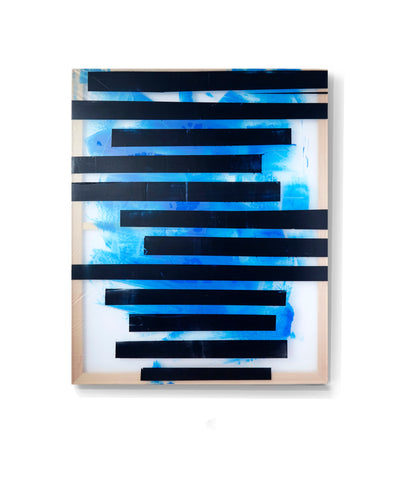
In Conversation | Tariku Shiferaw
HHCo: You were born in Addis Ababa, raised in LA and now live in New York. Could you tell us a bit about what origin means to you. Do the influences of Ethiopia play a minor or more instrumental role in the way you engage with your practice in the context of a western art scene/nexus?
TS: Origin, to me, refers to an original place where my ancestors come from. If possible, it’s important to remember our identities. Yes, the influences of Ethiopia play an instrumental role in the way I engage with my practice within the context of the western art world. My current body of work, ‘One of These Black Boys’ comes from a place of not belonging in the canon of western art history. Growing up in Los Angeles, I was often made to feel that I did not belong as an American. I was ‘othered’, often because of my name, which sounded more foreign than I wanted it to. This initially caused me to figure out what it means to be Black and simultaneously first generation immigrant in America.
HHCo: Your work plays on material – spray paint sits atop plastic, swashes of rich hues are covered, barred or perhaps given structure by solid geometric blocks – can you talk us through your process, your use of materials?
TS: My use of material depends on the type of work I’m making. Most of my paintings in this current series are made on either plastic or vinyl, and occasionally, on canvas. The works on plastic are stretched on stretcher-bars with several layers of plastic. The acrylic paint is often placed on every layer of plastic, building some sort of optical depth. The works on vinyl are spray painted on the back while masking the portions I want visible with tape. When the tape is removed, it reveals the material in the background – either Mylar or iridescent film.

HHCo: What do these materials represent, in particular the choice of colours?
TS: Most of my paintings in this body of work consist of the colours black and blue. I like blue. I’ve always liked blue. But something interesting happens in the juxtaposition of black and blue, it’s formally pleasing. There are multiple dichotomies that exist within the relationship of these two colours. Blue is the day sky and also reflected on bodies of water. It signifies peace and serenity, yet in music, the Blues are very sad. A similar thing happens with the colour black. It is represented in the night sky, in all its beauty it’s known as the absence of light. Black and blue are also the visible colours the Black skin bruises into. The Blues in music comes from the struggle life. I like how these two colours endlessly bounce off each other. Often times, even when I paint with transparent materials such as plastic or vinyl, I try to get these two colours to interact with the light that’s passing through them and the translucent materials. Also, my blacks are often not black, they’re Paynes grey, which consists of a little bit of blue.
HHCo: Can you tell us a bit about how music influences your work – the titles string a narrative of references, it’s interesting to think about how references to lyrics and words opens up further windows. Is this how you build your language or approach for a new piece of work? Do you start with the lyrics?
TS: Music has been a part of my life for as long as I can remember. I grew up listening and playing all sorts of music. It’s a free form of language that speaks to many different circumstances in my life – from joy, to sadness, to political displacement in society, and more. When it comes to Black diaspora music such as Hip-hop, R&B, Blues, Jazz, and Reggae, music is not just words but a culture of experienced history – the ups-and-downs and the wins and losses in life. I use the song titles of these music genres to title each piece within my current body of work, ‘One of These Black Boys.’ The layering of these titles marks my paintings in a way that points to the identity of the mark-maker.
I usually start producing the physical work and later return to title the work. Language and naming is important in the way one claims space in western society.
“There are three layers of mark-making that take place in my work. The first is the marking of the paint surface. The second is the titling of the painting, which introduces references that are not based on western art history. The third takes place during the exhibition of the work, the marking of the exhibition walls in a white cube”
HHCo: In particular, I was interested in the work King Kunta (2016), is this based on Kunta Kinte – the Alex Haley protagonist and both drawing back to Kendrick Lamar’s music, or is it largely referencing Lamar’s piece?
TS: Yes, it is. The multiple layers of references make it one of my favourite pieces from this series. ‘King Kunta (Kendrick Lamar)’ is a piece that was titled based on a track by Kendrick Lamar. The song references the character of Kunta Kinte from Alex Haley’s novel the Roots. I appreciate Lamar’s genius in overlaying the story of Kunta Kinte with his life in the ‘hood’. He concludes that, just like Kunta Kinte’s unstoppable strive for freedom, he too will continue despite all the ‘hatin’ and obstacles in his environment.
This piece is made of a draping black plastic that hangs eight feet tall with multiple blue horizontal spray-paint stripes. It resembles a majestic cape, which resounds with the title while also referring to cultural occurrences. To me, Hip-hop is the reincarnation of the Blues, which came from the struggle life. It’s a different genre but often hits the same blue notes in depicting the existence of Black bodies within the context of western society.
HHCo: Perhaps you can tell us a bit more about how working with music titles then pulls threads of new references into the work, immediately they inherit the references made by the artists who wrote those songs. This layering of meaning is also implicit in your layering of marks. Could you tell us a bit more about the symbolism or reading of layered meaning, marks, titles, clues or pointers.
TS: There are three layers of mark-making that take place in my work. The first is the marking of the paint surface. The second is the titling of the painting, which introduces references that are not based on western art history. The third takes place during the exhibition of the work, the marking of the exhibition walls in a white cube with ‘One of These Black Boys’ – slightly adjusting the identities of abstract paintings.
In ‘One of These Black Boys,’ every piece is titled using Hip-Hop, R&B, Blues, Jazz, and Reggae music. In appropriating song titles as painting titles, the work automatically inherits the references, identities, and history portrayed through the songs. When perceived contextually, each work becomes a placeholder that occupies the walls of a white cube. The titles create a different set of content outside of the discourse of painting, which suggests an act of rebellion against a rigged past. While “mark-making” remains as a painting terminology, these paintings become the actual mark that interrupts the space and history.
“In the song, Nas and Lauryn Hill depict an alternative reality other than the one that’s given. They search for a world without “cops harassing,” a world where Black men are freed, and a world where wealth is distributed to those who don’t have anything.”
HHCo: I’m interested in the representation of the black male figure in your work – references to societal structures, the black male or female figure within a predominantly white arts community for example – is that a truth you grapple with in the work?
TS: In ‘One of These Black Boys’, my work represents the paintings that are titled after Black diaspora music. I don’t distinguish between the Black male or female gender. However, I can understand how most perceive it because of the word ‘Boys’ in the title.
The western art world has been the same everywhere; I don’t think there’s any distinction between New York and other parts of the United States, for example. The art world has always favoured white-male artists. It’s the very reason why I titled this abstract body of work using Black diaspora music titles. In recent history, abstract paintings have been culturally recognized as something that belongs to white artists only. This was because only white-male artists were recognized for it, while women and artists of colour were pushed to the background.
HHCo: Perception played a big part of my experience of your work. From a distance, there are bold and striking forms – the hung figure of a human, visually weighted and hunched, on closer inspection is a tagged sheet of light plastic (King Kunta, 2016); blocks of black on white, strong markers of censoring perhaps, on near sight show through to details of the ‘backstage’, the wooden framework holding the artwork in place (If I ruled the world, 2016)– that ‘grey space between meaning’[1] and perception – can you talk to us a bit about that.
TS: Yes, most of my pieces have horizontal strips covering the surface area. The piece, ‘King Kunta (Kendrick Lamar),’ is made of a black plastic with blue spray paint. Unlike other works, this piece hangs from only one point atop and appears like a draping garment. Many see different things when encountering this piece. I like how it hangs like a garment, specifically like a cape of some sort; perhaps just like a superhero or a royal cape. The title ‘King Kunta’ references to many things, starting with Kendrick Lamar’s song, but the song refers to Alex Haley’s novel ‘Roots’ comparing Kunta Kinte’s character to Kendrick Lamar’s in his ‘hood’ environment. This Hip-Hop track touches on subject matters that the Blues hit on, the struggle life and oppression.
The painting ‘If I Rule The World (Nas)’ functions in a similar way. Layers of transparent plastic stretched on a stretcher bar. Between the second and third layer of stretched plastic is where the horizontal acrylic paint markings live. In the song, Nas and Lauryn Hill depict an alternative reality other than the one that’s given. They search for a world without “cops harassing,” a world where Black men are freed, and a world where wealth is distributed to those who don’t have anything. The black horizontal stripes are only supposed to mark the surface of the painting, but as the piece developed, it marked ideas of the very lyrics the piece is titled after. This is the first piece made in the series ‘One of These Black Boys’ and it’s where I realized the titles of these paintings had become very powerful in ways that they marked the paintings through other external references bringing them into conversation about culture and history outside of painting discourse.
HHCo: There can be curiosity tied to culture and origin – how do you feel about being highlighted as an Ethiopian artist or artist of Ethiopian origin, given you were raised in the US and how present and relevant do you think your origin actually is to your practice today?
TS: Yes, usually there is. However, beyond the curiosity, I would hope it’d help bring some positive attention to younger artists coming out of Ethiopia.
My background is very important to my practice. My work wouldn’t be the same if I had not experienced the complexities of being ‘Othered’ for being a Black immigrant in the U.S. My identity allows me to engage society from multiple perspectives.
HHCo: I am interested in questions of opacity, in terms of how Edouard Glissant explores these notions – untransability, unknowability opacity’s radical potentiality for social movements to challenge and subvert systems of domination. Opacity seems to be a physicality in your work that is reiterated and reimagined visually on a number of levels …
TS: I like how you talk about the idea of opacity, but it was not my intention. I just wanted to make paintings that had a formalist dialogue while amalgamating them with a new culture that I identified with.
HHCo: At Hundred House, origin is something we think about on a daily basis – trade, fair exchange and ethical integrity. One half of our team is also from Mauritius, a small island steeped in colonial history, in hard human marks made and felt upon cultures living today that tread back hundreds of years. We’re really interested in getting to grips with the origins that we work with, to highlight what is current about a place – on site at origin and also with the diaspora stemming from that place.
Looking towards Ethiopia – are there any artists or musicians that you would recommend we keep an eye/ear out for? Are there galleries, music venues, cultural spots you’d recommend us to seek out next time we are there?
TS: I like Teddy Afro’s music. Yes, check out Addis Fine Art and the local artist they represent in Ethiopia.
HHCo: Turning to where you live now, New York, is there anywhere you’d recommend a visitor to check out, places you particularly enjoy?
TS: Studio Museum Harlem, Brooklyn Museum, The New Museum, Basquiat’s Bottle (restaurant/bar), and I’m sure there many I’m forgetting at this moment…
[1] Tadias Magazine, September 11, 2018
For more visit: tarikushiferaw.com




